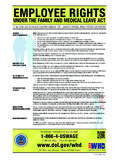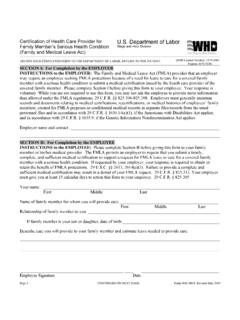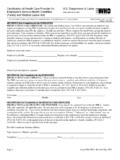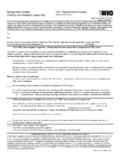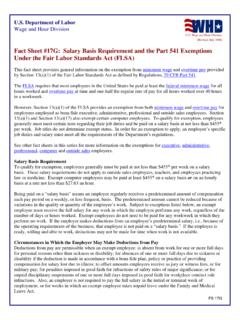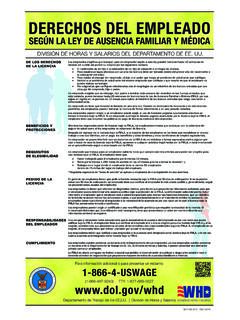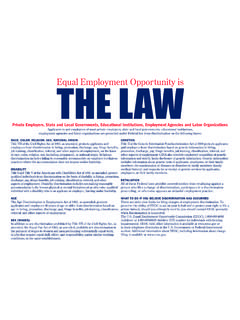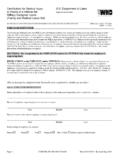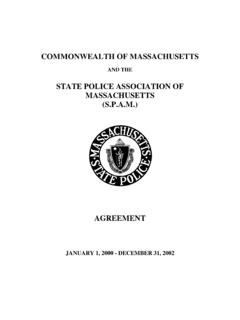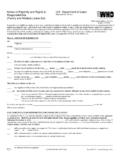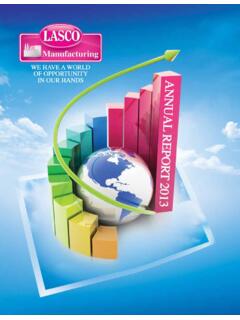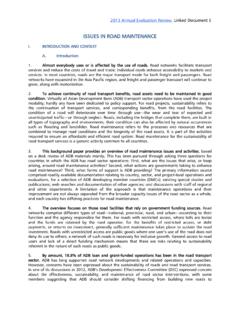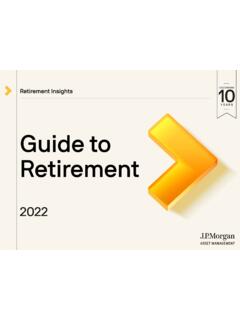Transcription of 2022 MHPAEA Report to Congress
1 2022 MHPAEA Report to Congress Secretary Martin J. Walsh Secretary Xavier Becerra Department of Labor Department of Health & Human Services Secretary Janet L. Yellen Department of the Treasury Realizing Parity, Reducing Stigma, and Raising Awareness: Increasing Access to Mental Health and Substance Use Disorder Coverage TABLE OF CONTENTS PREFACE .. 6 Enforcement 10 of Section 203 of Title II of Division BB of the 10 s MHPAEA Enforcement Activity under the CAA .. 11 MHPAEA Enforcement Activity under the CAA .. 25 s FY2020 Enforcement Evaluation 35 EBSA Enforcement 38 III. Outreach and Consumer and Compliance Assistance Efforts .. 39 Consumer Assistance 40 41 C.
2 State Partnership 44 D. Federal Partnerships to Advance Parity .. 44 Assistance .. 45 to the Regulated 47 Part 45 .. 48 : Strengthening MHPAEA s Consumer 51 55 2 PREFACE The Paul Wellstone and Pete Domenici Mental Health Parity and Addiction Equity Act of 2008 ( MHPAEA ) requires the Secretary of Labor to submit a Report to the appropriate committees of Congress on compliance by group health plans (and health insurance coverage offered in connection with such plans) with MHPAEA s requirements. The first such Report was due by January 2012 , and additional reports have been delivered every two years since. The Department of Labor s (DOL) 2012 and 2014 Reports to Congress provided an overview of the interim final rules, final rules, and related guidance that implement MHPAEA .
3 The 2012 and 2014 Reports also described DOL s general strategy of working with plans, issuers, consumers, providers, states, and other stakeholders to help the regulated community comply with the law and help families and individuals understand the law and benefit from it, as Congress intended. In addition to summarizing recent guidance issued by DOL, the 2016 Report to Congress detailed DOL s significant enforcement efforts and provided numerous examples of situations in which DOL was able to intervene on behalf of participants and beneficiaries to ensure that they received coverage for the health care to which they were entitled. DOL s 2018 Report to Congress supplemented the 2016 submission by further highlighting DOL s continued parity implementation efforts. It also outlined DOL s strategy for continuing to identify and correct MHPAEA non-compliance and minimize the likelihood of future violations through effective outreach, compliance assistance, and interpretive guidance.
4 The 2020 Report to Congress summarized DOL s activities to further parity implementation since the 2018 Report to Congress , including DOL s partnership efforts across the Administration, as well as with plans, issuers, consumers, providers, states, and other stakeholders. The 2020 Report detailed DOL s intent to use the information gathered from these partnerships to develop a roadmap to compliance for the regulated community so that health plan participants and beneficiaries are able to realize the full benefits of MHPAEA . Following the inauguration of President Biden and Vice President Harris, the DOL, along with the Departments of Health and Human Services (HHS) and the Treasury (collectively, the Departments) have made an unprecedented commitment to build on their longstanding efforts to advance mental health parity by making MHPAEA enforcement a top priority.
5 Although compliance assistance efforts remain an important part of the Departments MHPAEA efforts, feedback from stakeholders makes it clear that compliance assistance alone is not sufficient, and a greater emphasis on proactive enforcement is required. Responding to similar feedback, in the Consolidated Appropriations Act, 2021 (CAA), Congress furnished the Departments with an important new enforcement tool by amending MHPAEA to require plans and issuers to provide comparative analyses of their non-quantitative treatment limitations (NQTLs) to the Secretary of the Treasury, the Secretary of Labor, and the Secretary of HHS (collectively, the Secretaries) upon request and to authorize the Secretaries to determine whether those NQTLs comply with MHPAEA . This 2022 MHPAEA Report to Congress (2022 Report ) highlights the Secretaries recent emphasis on greater MHPAEA enforcement and discusses the significant resources dedicated to supporting these efforts.
6 As the first Report since the enactment of the CAA, the 2022 Report also details the efforts by the Departments to interpret, implement, and enforce the amendments to MHPAEA made by the CAA. This 2022 Report also provides information to follow up upon the fiscal year (FY) 2020 Mental Health and Substance Use Disorder (MH/SUD) Enforcement Evaluation Program outlined in the 2020 Report . This 3 2022 Report is intended to satisfy both the requirement under section 712(f) of the Employee Retirement Income Security Act (ERISA) that DOL provide a biennial Report to Congress on MHPAEA compliance, and the requirement under section 203 of title II of Division BB of the CAA that the Departments provide an annual Report to Congress on the NQTL comparative analyses.
7 The MHPAEA enforcement fact sheet, attached as an appendix, is intended to fulfill the Departments reporting requirements under section 13003 of the 21st Century Cures Act, as amended by section 7182 of the Substance Use-Disorder Prevention that Promotes Opioid Recovery and Treatment for Patients and Communities Act (Support Act).1 CAA Enforcement Results Fast Facts: The following is an overview of the key enforcement results under section 203 of Title II of Division BB of the CAA, which are explained more fully in Section below: The Employee Benefits Security Administration (EBSA) has issued 156 letters to plans and issuers requesting comparative analyses for 216 unique NQTLs across 86 The Centers for Medicare & Medicaid Services (CMS) issued 15 letters between May and November 2021 to issuers in states where CMS has direct enforcement authority over MHPAEA (Texas, Missouri, and Wyoming) and to non-Federal governmental plan sponsors in those and other states.
8 None of the comparative analyses reviewed to date have contained sufficient information upon initial receipt. EBSA observed several common themes in deficiencies: o Failure to document comparative analysis before designing and applying the NQTL; o Conclusory assertions lacking specific supporting evidence or detailed explanation; o Lack of meaningful comparison or meaningful analysis; o Non-responsive comparative analysis; o Documents provided without adequate explanation; o Failure to identify the specific MH/SUD and medical/surgical benefits or MHPAEA benefit classification/s affected by an NQTL; o Limiting scope of analysis to only a portion of the NQTL at issue; o Failure to identify all factors; o Lack of sufficient detail about identified factors; o Failure to demonstrate the application of identified factors in the design of an NQTL; and o Failure to demonstrate compliance of an NQTL as applied.
9 1 Pub. L. 115-271 (Oct. 24, 2018). 2 This count of unique NQTLs only includes limitations that the Department has identified under a plan or health coverage that the plan or issuer has defined using different factors or evidentiary standards than other NQTLs, regardless of whether it is applied to different classifications, or to different plans (in cases where a request was made to a health insurance issuer). Counting each NQTL separately by benefit classification, plan, and product, the number of NQTLs for which EBSA requested a comparative analysis would be 1,112. 4 EBSA has issued 80 insufficiency letters for over 170 NQTLs, requesting additional information and identifying specific deficiencies. CMS has issued 19 insufficiency letters identifying deficiencies in the comparative analyses and requested additional information to address these deficiencies.
10 EBSA has so far issued 30 initial determination letters finding 48 NQTLs imposed on MH/SUD benefits lacking parity with medical/surgical benefits (36 unique NQTLs). CMS has so far issued 15 initial determination letters to plans and issuers finding 16 NQTLs out of parity with medical/surgical benefits. Two NQTLs were found to be impermissible separate treatment limitations in effect and 14 comparative analyses remained insufficient. EBSA received corrective action plans from 19 plans in response to initial determination letters. These corrective action plans address 36 NQTLs (30 unique NQTLs). CMS received corrective action plans from 6 plans and issuers in response to initial determination letters. These corrective action plans address 13 NQTLs. 26 plans and issuers so far have agreed to make prospective changes to their plans.
